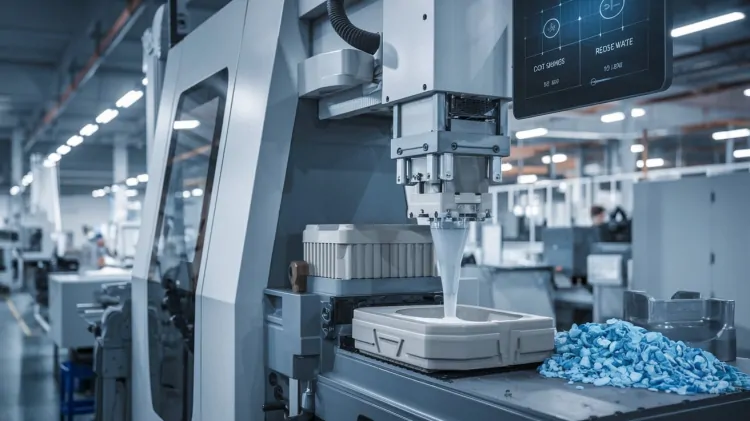How to Reduce Waste and Cost in Injection Moulding Projects
Learn effective strategies to reduce waste and minimize costs in injection moulding projects. Optimize production efficiency, enhance material usage, and improve profitability with these expert tips.

Injection moulding is one of the most versatile and widely used manufacturing processes, particularly in creating plastic components for various industries, from automotive to consumer goods. However, one common challenge businesses face is the cost and waste associated with injection moulding projects. Reducing both waste and cost not only helps improve the efficiency of production but also contributes to environmental sustainability. In this blog, we’ll explore effective ways to minimize waste and cut down costs in injection moulding projects.
Understanding Injection Moulding
Injection moulding is a process where molten plastic is injected into a mould to form a specific shape. This method is highly efficient for mass production, producing consistent and precise parts with minimal variation. However, if not optimized, the process can result in excess material waste and high operational costs.
The Importance of Reducing Waste in Injection Moulding
Reducing waste is crucial not only for cost savings but also for environmental responsibility. Wasted plastic material often ends up in landfills, contributing to pollution and resource depletion. By minimizing waste, manufacturers can enhance sustainability efforts, lower material expenses, and improve the overall efficiency of the injection moulding process.
1. Optimize Design for Manufacturability
a. Focus on Part Design
One of the most significant factors contributing to both waste and cost in injection moulding is the design of the part being produced. A complex design that includes unnecessary features may require more material, longer cycle times, and additional tooling costs. Here’s how you can optimize design for manufacturability:
-
Simplify geometry: Avoid overly intricate shapes or undercuts that require complex mould designs.
-
Uniform wall thickness: Ensure that the walls of the part have consistent thickness to avoid material wastage and ensure uniform cooling.
-
Minimize unnecessary features: Eliminate features that do not contribute to the functionality of the part, reducing the amount of material required.
By optimizing part design, you can significantly reduce both material waste and production time, leading to cost savings.
b. Use Simulation Tools
Before moving to actual production, using injection moulding simulation software can help identify potential issues with the part design and mould configuration. These tools allow you to test different variables like material flow, temperature, and pressure, providing insights into how to optimize the process to minimize waste. Simulation tools help in refining the part and mould design, ultimately reducing the risk of errors and production delays.
2. Material Selection and Recycling
a. Use Recycled or Biodegradable Materials
Selecting the right material is essential for reducing waste in injection moulding. Opt for recycled plastics or biodegradable materials whenever possible. These materials not only lower the environmental impact but can also lead to cost savings by using readily available recycled inputs. Additionally, many plastics can be re-ground and reused within the same production line.
b. Material Efficiency
Material cost is one of the primary expenses in injection moulding projects. To minimize waste, use only the amount of material necessary for the part. Careful calculation of the material volume required for each shot can help prevent overuse. Furthermore, manufacturers can implement systems that monitor and control the amount of plastic used in the injection process, ensuring minimal wastage.
3. Optimize the Mould Design
a. Invest in High-Quality Moulds
The design and quality of the mould play a crucial role in minimizing waste during the injection moulding process. A poorly designed or low-quality mould can lead to defects such as flashing, warping, or incomplete filling, all of which result in wasted material. Invest in high-quality moulds that are tailored to the specific part design. While the initial cost may be higher, the long-term savings from reduced waste and fewer defects will outweigh the upfront investment.
b. Maintain Proper Mould Ventilation and Cooling
Proper ventilation and cooling systems in the mould can significantly reduce the risk of defects such as bubbles, warping, or burn marks, which often lead to wasted material. By ensuring that the mould is correctly vented and cooled, you can improve the quality of the finished parts, reducing the need for rework or scrap.
4. Improve Production Efficiency
a. Minimize Cycle Times
Reducing cycle time is another effective way to cut costs in injection moulding. Cycle time refers to the total time taken to complete one production cycle, including the injection, cooling, and ejection of the part. Optimizing cycle time through better mould design, faster cooling, and efficient machine settings can lead to higher throughput and reduced energy consumption, which directly impacts cost savings.
b. Regular Maintenance of Machines and Moulds
To avoid unexpected downtime or defects that lead to material waste, regular maintenance of the injection moulding machines and moulds is crucial. Preventive maintenance ensures that all equipment is running smoothly, preventing costly breakdowns that can halt production and lead to wasted material.
5. Train Your Team
Having a well-trained team is essential for reducing waste in injection moulding projects. Operators who understand the intricacies of the process are better equipped to identify issues early and make necessary adjustments to avoid material waste. Investing in training for your staff can result in more efficient production processes and reduced errors.
Conclusion
Injection moulding projects can be optimized to reduce waste and lower costs through various strategies, including optimizing part and mould design, selecting efficient materials, improving production processes, and maintaining equipment. By focusing on these key areas, manufacturers can not only reduce their operational expenses but also contribute to a more sustainable manufacturing process.
Implementing these best practices will help you streamline your injection moulding projects, ensuring you save both time and money while reducing your environmental footprint. By making smart decisions in design, materials, and production, waste can be minimized, and efficiency maximized.
What's Your Reaction?














